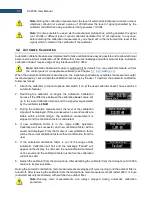
47
SV 200A User Manual
6
REMOTE COMMUNICATION
SV 200A is equipped with three modules that can maintain remote communication with the instrument:
•
GSM modem (3G),
•
WLAN/ LAN module and
•
Bluetooth module.
There is dedicated software that supports remote communication with SV 200A:
•
+_RC for remote configuration, remote control, data retrieving and data processing,
•
SvanNET web-service for remote control and data retrieving,
•
Svannet App for remote communication configuration.
6.1 M
AIN COMMUNICATION CHANNEL
Main communication channel is the TCP/IP connection (a lossless data exchange protocol) that can be used
to exchange commands as specified by Appendix A to SV 200A User Manual. + assures this
connection and provides data download, configuration, performance validation and measurement start/stop.
Main communication channel of SV 200A can be established by one of two available methods: TCP/IP Client
or TCP/IP Server. The SV 200A stations firmware version 1.03.4 does not support SSL (Secure Socket
Layer) connections.
The
TCP Client
is a mode of main communication channel in which SV 200A is configured to initiate
connection to a designated address (
remote host
). SV 200A attempts to establish a TCP/IP connection to a
designated address on a designated port (
Data Port
) automatically. Should the connection be established
successfully, SV 200A can exchange commands with the remote server. Should the connection attempt fail
or is broken by the
remote host
, SV 200A will attempt to reconnect again. To prevent the connections from
going
idle
(a state in which the TCP/IP connection seems to be active, but no data can be transferred), the
station maintains the connection to the server by sending small packages of data at keep alive period (which
by default is one minute). If the transfer is not properly acknowledged by the other party, the connection will
be terminated.
Note: TCP Client mode is used in the SvanNET web-service. +_RC supports all
modes of TCP/IP connection.
SV 200A uses the TCP Client mode to connect to SvanNET (this is the default setting of the station) or
another user defined server. The user also connects to SvanNET via web browser or +, and the
service creates a "bridge" between the station and the user. In this case for 3G communication there are no
restrictions on the SIM-card tariff (no public IP address is required) and simple internet access is enough.
The essence of SvanNET is to simplify the procedures and requirements necessary for the connection.
TCP Server
is a mode in which SV 200A is configured to act as a server for incoming connections. SV 200A
is waiting for the first connection to be established on a designated port (called
Data Port
; default 8000).
Such connection can come from any application - an initiator of the TCP/IP connection (such as +)
called
remote peer
. For 3G communication this mode requires the SIM-card with a
public address
(called
public IP
).
6.2 SMS
/
E-
MAIL ALARMING
SMS/E-mail alarming functionality allows SV 200A to inform the user about different events eg. exceeded
thresholds, low battery etc. by SMS and/or E-mail notification. SV 200A can send an SMS to a defined
number(s) and/or an E-mail to a defined address(es) with alarm and its details.
SV 200A has implemented advanced alarm mode. Advanced alarms configuration can be performed using
SvanNET or + application in Station Configuration of the Remote Communication Center (see
Chapter
). The E-mail alarming uses SvanNET e-mails feature to send e-mails. The benefits of
SvanNET e-mails is that the user does not required to have any e-mail client account on SMTP server and
that e-mails are SSL encrypted. The content of the message is created automatically.















































